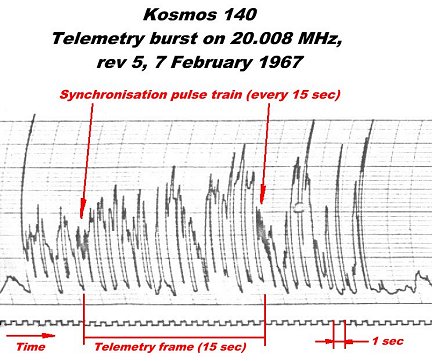Soyuz telemetry bursts
Sven Grahn
Kosmos-140 was launched
into a 165-218 km, 51.6 deg orbit at 0322 UT on 7 February, 1967 and
gave
the Kettering Group its first sample of Soyuz-type
telemetry on shortwaves. Actually, neither myself nor Geoff
Perry
had the opportunity to pick it up, but Ken Edwards, the Senior
Technician
at the Physics Department at the University College of Wales,
Aberystwyth,
chart-recorded signals on 20.008 MHz which Geoff identified as
originating
from Kosmos-140. He did this during automatic monitoring the nearby
frequency
of 20.005 MHz for signals from Explorer 22. These were later found to
be
the typical PDM
telemetry
of a Soyuz. (It was subsequently learned that TASS had given
the
frequency 20.008 MHz in its launch announcement).
Aberystwyth picked up
the
signals
on revolutions 5, 21, 22, and 23. (On rev 5 the
spacecraft passed right over Aberystwyth and the signals on the
chart below were recorded). On all occasions the signals were
transmitted
in bursts: 30 seconds on and 90 seconds off. This behaviour enabled
Geoff
to identify Kosmos-186 as a Soyuz-type spacecraft during the automatic
docking mission Kosmos-186/188. Similar behaviour was observed with the
Kosmos 212/213 mission and, with this, it was discovered that the
telemetry
was actually transmitted on 15.008 MHz during part of the off period on
20.008 MHz.
 In
connection with ASTP, detailed information about the command-signalling
device in the Soyuz cockpit showed that the Soyuz short-wave
transmitter
could be cycled through four different frequencies, presumably to cover
all possible HF bands so that at least one 30 second burst would get
through
- independent of spacecraft location - a very clever emergency
signalling
system.
In
connection with ASTP, detailed information about the command-signalling
device in the Soyuz cockpit showed that the Soyuz short-wave
transmitter
could be cycled through four different frequencies, presumably to cover
all possible HF bands so that at least one 30 second burst would get
through
- independent of spacecraft location - a very clever emergency
signalling
system.
What frequencies were
used?
Well, I think they were 20.008 MHz, 15.008 MHz as observed and also
18.060
MHz (originally 18.035 MHz) and one more frequency which is not
known..!
Or perhaps the fourth slot was to be used for voice? 20.008 MHz,
15.008 MHz and 18.060 MHz (originally 18.035 MHz) were the only Soyuz
frequencies
ever given in official TASS announcements!
Signals on shortwaves
from
Soyuz also were often observed all along the orbit which explains the
interest
in the frequency hopping exercise to try to find the frequency that
best
propagated around the world. The simple keyed beacon signal propagated
all around the earth in what is called "ionospheric wave ducts" giving
an effect often called "the whispering gallery effect". A peculiarity
observed
during "whispering gallery propagation" was that the signal from the
Soyuz
increased abruptly as the spacecraft reached the antipode. At that
point
all HF signal energy radiated horizontally reached the antipode! We
used
to call this the "antipode effect".

 Back
to Space Tracking Notes
Back
to Space Tracking Notes
 In
connection with ASTP, detailed information about the command-signalling
device in the Soyuz cockpit showed that the Soyuz short-wave
transmitter
could be cycled through four different frequencies, presumably to cover
all possible HF bands so that at least one 30 second burst would get
through
- independent of spacecraft location - a very clever emergency
signalling
system.
In
connection with ASTP, detailed information about the command-signalling
device in the Soyuz cockpit showed that the Soyuz short-wave
transmitter
could be cycled through four different frequencies, presumably to cover
all possible HF bands so that at least one 30 second burst would get
through
- independent of spacecraft location - a very clever emergency
signalling
system.